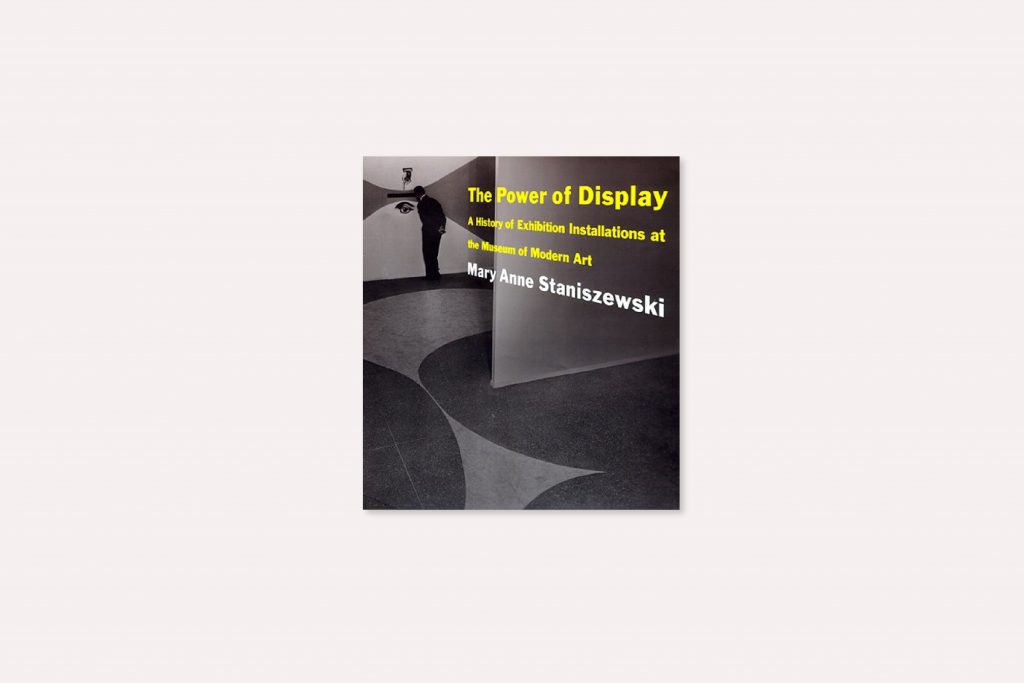HOW CAN WE LOOK AT ‘EXHIBITION’ IN OTHER WAYS THAN A SITE OF EXHIBITION OR DISPLAY? READING LIST THIS WEEK INTRODUCES THREE BOOKS THAT WILL BROADEN YOUR VIEW TOWARDS THE MAKING OF EXHIBITION IN MORE DIMENSIONS
TEXT: PAPHOP KERDSUP
PHOTOS COURTESY OF THE PUBLISHERS
เราจะสามารถทำความเข้าใจนิทรรศการในมุมมองอื่นที่มากกว่าพื้นที่จัดแสดงได้อย่างไร? Reading List สัปดาห์นี้ชวนอ่านหนังสือ 3 เล่ม ที่จะมาเปิดมุมมองให้คุณได้คิดกับการทำนิทรรศการในมิติที่หลากหลายมากยิ่งขึ้น

The Power of Display: A History of Exhibition Installation at the MoMA
Mary Anne Staniszewski
The MIT Press, 1998
Hardcover, 400 pages, 24.8 x 25.4 cm
ISBN 978-0262194020
การติดตั้งและจัดแสดงผลงานศิลปะสามารถบอกอะไรกับเราได้บ้าง? ใน The Power of Display ซึ่งตีพิมพ์เมื่อปี 1998 และขาดตลาดมาจนถึงทุกวันนี้ Staniszewski ได้พาเราไปสำรวจบทบาทของ “การจัดแสดง” ที่บ่อยครั้ง (หรือแม้แต่ในปัจจุบันเอง) มักถูกมองข้าม ผ่านการใช้นิทรรศการที่เคยถูกจัดแสดงภายใน MoMA ในนิวยอร์กเป็นจุดตั้งต้นของวิเคราะห์ร่วมกับเทคนิคการจัดแสดงที่อยู่นอกเหนือไปจากรูปแบบของสถาบันศิลปะในปัจจุบัน ตั้งแต่การจัดแสดงสินค้าในห้าง การจัดแสดงวัตถุในพิพิธภัณฑ์ประวัติศาสตร์ จนถึงการจัดแสดงงานศิลปะของกลุ่มศิลปินอาวองการ์ดในช่วงครึ่งแรกของศตวรรษที่ 20 ทั้งหมดทั้งมวลนี้ ก็เพื่อตั้งข้อสังเกตและพยายามตอบคำถามให้กับประเด็นต่างๆ ที่แวดล้อมคำว่า “the power of display” หรือ “พลังอำนาจของการจัดแสดง” อย่าง การออกแบบนิทรรศการส่งผลกระทบต่อความหมายและการรับรู้องค์ประกอบต่างๆ ภายในพื้นที่นั้นอย่างไรบ้างเมื่อมันถูกจัดแสดง? หรือการหลงลืมสิ่งที่หนังสือเล่มนี้พยายามสำรวจส่งผลต่อประวัติศาสตร์ศิลปะ โลกศิลปะ หรือแม้กระทั่งความทรงจำร่วมทางวัฒนธรรมอย่างไรบ้าง? เป็นต้น
What can we analyze and learn from the installations and displays of contemporary art? In the out-of-print ‘The Power of Display’ published in 1998, Staniszewski examines the overlooked role of ‘display’ in installation design. The exhibitions at the MoMA are used as a starting point for analysis of their display techniques as well as the display of commercial goods in department stores, artifacts in the natural history museum, and works of art in the avant-garde’s exhibitions during the first half of the 20th century. All this aims to investigate and find answers for questions that revolve around the idea of ‘the power of display’ such as ‘how do exhibition designs affect the meaning and reception of specific components in an exhibition when they are displayed?’ or ‘how does an amnesia regarding what this publication is trying to observe affect art history, the art world, or even collective cultural memories?’


The Senses: Design Beyond Vision
Ellen Lupton and Andrea Lipps
Princeton Architectural Press, 2018
Hardcover, 224 pages, 17.5 x 22.6 cm
ISBN 978-1616897109
The Senses: Design Beyond Vision เป็นทั้งแคตตาล็อกของนิทรรศการในชื่อเดียวกันซึ่งจัดขึ้นที่ Cooper Hewitt ในนิวยอร์กไปเมื่อปีที่ผ่านมา และถ้อยแถลง (manifesto) ของคิวเรเตอร์ Ellen Lupton และ Andrea Lipps (รวมทั้งตัว Cooper Hewitt เอง) ที่ต้องการจะกระตุ้นประเด็นเกี่ยวกับการออกแบบเพื่อทุกคน หรือ inclusive design ให้หลุดออกมาจากกรอบคิดแบบเดิมๆ และขยายขอบเขตไปให้ไกลกว่าแค่การออกแบบเพื่อสนองต่อ “การมองเห็น” ด้วยการนำเสนอแนวคิดการออกแบบแบบพหุประสาทสัมผัส (multisensory design) ที่ทั้งการได้ยิน การได้กลิ่น การลิ้มรส และการสัมผัส ต่างก็มีบทบาทที่สำคัญไม่แพ้กัน ในบทความ ‘The Inclusive Museum’ ที่ได้ Sina Bahran ผู้ก่อตั้ง Prime Access Consulting มาเล่าถึงความประทับใจในวัยเด็กที่ตัวเขาเองในฐานะเด็กชายผู้พิการทางสายตา ได้ใช้ประสาทสัมผัสอื่นๆ เรียนรู้สิ่งที่อยู่ในพิพิธภัณฑ์ พร้อมกับการตั้งข้อสงสัย (และข้อเสนอแนะ) ถึงการนำหลักการออกแบบเพื่อทุกคนมาใช้ในปัจจุบันนั้น ได้ฉุกให้เรากลับมาคิดกับการออกแบบประสบการณ์และนิทรรศการกันอย่างจริงๆ จังๆ เพราะการออกแบบเพื่อทุกคนไม่ได้จบแค่การเพิ่มทางลาด แต่มันมีอะไรมากกว่านั้น “ทุกวันนี้เราได้นำประสาทสัมผัสทุกอย่างมาใช้กับคนทุกกลุ่มแล้วหรือยัง?” จึงเป็นเหมือนคำถามที่ The Senses ต้องการจะฝากไว้ให้กับคนทำงานสร้างสรรค์ทุกสาขาได้คิดกันต่อ
Both a catalogue of the eponymous exhibition held at the Cooper Hewitt, Smithsonian Design Museum in New York City last year and a manifesto of the curators Ellen Lupton and Andrea Lipps as well as the Cooper Hewitt themselves, ‘The Senses: Design Beyond Vision’ seeks to encourage the notion of inclusive design to go beyond its own boundary as a ‘visual’ pursuit by addressing the concept of multi-sensory design which takes all other senses into account, from hearing and smelling to taste and touch, all of which are equally as powerful as sight. In one of the articles ‘The Inclusive Museum,’ an accessibility consultant and a founder of Prime Access Consulting, Sina Bahran recalls his childhood impression being a disabled boy who got to use all of his senses to explore and experience things in a museum. He remarks on the ubiquitous use of universal or inclusive design nowadays and comes up with suggestions that make us really come back to reconsider the importance of experience and exhibition design because an inclusive design is not just about making a wheelchair ramp and so on, but it is more than that. All in all, a question like ‘are we incorporating every sense with every group of people right now?’ seems to be what The Senses has left behind for all the protagonists in the creative industry to ponder.


Design and the Elastic Mind
Paola Antonelli and Hugh Aldersey-Williams
The Museum of Modern Art, 2008
Paperback, 192 pages, 19 x 24.1 cm
ISBN 978-0870707322
Design and the Elastic Mind เป็นนิทรรศการที่ MoMA ในปี 2008 ซึ่งชวนเรากลับมาสำรวจพัฒนาการทางเทคโนโลยี สังคม และการออกแบบในช่วงทศวรรษนั้น ไปพร้อมๆ กับการพยายามทำความเข้าใจความเปลี่ยนแปลงที่เกิดขึ้น (หรืออาจจะเรียกว่าได้เป็นการคลื่นลูกแรกๆ ของการพลิกโฉมทางเทคโนโลยี) ผ่านงานวิจัยและโปรเจ็คต์หลากหลายสเกลตั้งแต่เล็กจิ๋วระดับนาโนจนถึงใหญ่มหึมาระดับจักรวาล เพื่อที่จะฉายภาพอนาคตให้ชัดเจนขึ้น รวมทั้งแสดงให้เห็นว่ามนุษย์เรานั้นปรับตัวเพื่อรองรับและตอบสนองต่อพัฒนาการต่างๆ ได้อย่างยืดหยุ่นแค่ไหน Paola Antonelli สร้างความน่าสนใจให้กับนิทรรศการด้วยการใช้ทั้งพื้นที่ทางกายภาพของ MoMA และพื้นที่เสมือน (virtual space) บนโลกอินเตอร์เน็ตของเว็บไซต์นิทรรศการเป็นพื้นที่จัดแสดง โดยที่ข้อมูลที่ถูกบรรจุอยู่ในทั้งสองแพลตฟอร์มนั้นต่างก็มีบทสนทนาระหว่างกัน แคตตาล็อกของนิทรรศการเล่มนี้นอกจากจะทำหน้าที่บันทึกรายการสิ่งของที่ถูกจัดแสดงแล้ว ยังเป็นอีกหนึ่งแพลตฟอร์มของการสื่อสารที่มีบทบาทไม่แพ้พื้นที่จัดแสดงทั้งสองข้างต้น ผ่านบทความจาก Antonelli เอง และนักเขียนรับเชิญจากหลายหลายสาขาวิชาที่ถูกใช้ควบคู่ไปกับนิทรรศการ โดยเนื้อหาบางส่วนนั้นหาอ่านจากที่ไหนไม่ได้เลย แม้แต่ในพื้นที่จัดแสดงและเว็บไซต์เอง ซึ่งถ้าจะว่ากันตามตรงแล้ว Design and the Elastic Mind เล่มนี้ถือเป็นวิธีการใช้สิ่งพิมพ์ในฐานะอีกหนึ่งพื้นที่จัดแสดงได้อย่างน่าสนใจทีเดียว
Exhibited at the Museum of Modern Art in 2008, ‘Design and the Elastic Mind’ was an exhibition that took us on an exploration of the advances of technology, society, and design during the outset of the 21st century while it was also trying to understand the significant shifts of that period—the early wave of technological disruption, so to speak—through research and projects of diverse scales from the nano to the cosmological. It also demonstrated how elastic we are, as human beings, to adapt and respond to an array of developments. The curator, Paola Antonelli made the exhibition even more intriguing by using both the physical space in the MoMA and a virtual space on the Internet to act as exhibition spaces with content and information contained in/on the two platforms having a back and forth dialogue. When it comes to the exhibition catalog, it does not, however, only perform as documentation of objects that were exhibited in the exhibition but also becomes another communication platform that plays as important a role as the physical and virtual ones. With articles written by Antonelli herself and other guest contributors from various disciplines that are concurrently used with the exhibition, some of which you cannot read anywhere else even in the exhibition at the MoMA or on its website, ‘Design and the Elastic Mind’ has shown us an interesting way to push forward a publication as the site of an exhibition.


